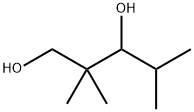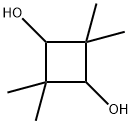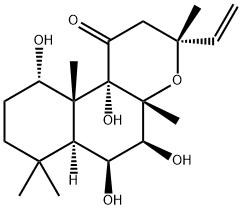2,2,4-Trimethyl-1,3-pentanediol
- CAS NO.:144-19-4
- Empirical Formula: C8H18O2
- Molecular Weight: 146.23
- MDL number: MFCD00004681
- EINECS: 205-619-1
- SAFETY DATA SHEET (SDS)
- Update Date: 2024-12-18 14:08:52

What is 2,2,4-Trimethyl-1,3-pentanediol?
Chemical properties
(96% pure): White solid. Slightly soluble in water; soluble in alcohol, acetone, ether, and benzene. Combustible.
Chemical properties
2,2,4-Trimethyl-1,3-pentanediol is a somewhat volatile liquid.
The Uses of 2,2,4-Trimethyl-1,3-pentanediol
Main uses of 2,2,4-Trimethyl-1,3-pentanediol are as a component of polyester resins used in food packaging and as an insect repellent. Industrial exposure is likely to be by direct contact with the liquid. Vapors or mists may be encountered under some conditions.
The Uses of 2,2,4-Trimethyl-1,3-pentanediol
Polyester resins, plasticizers, lubricants, surface coatings and printing inks, insect repellent.
The Uses of 2,2,4-Trimethyl-1,3-pentanediol
2,2,4-Trimethyl-1,3-pentanediol is used in the synthesis of monoisobutyrate derivatives used in film forming auxilleries in paint substances.
Production Methods
2,2,4-Trimethyl-1,3-pentanediol is made by reacting isobutyryl chloride with ethyl isobutyrate.
Definition
2,2,4-Trimethyl-1,3-pentanediol (TMPD) glycol, with one primary and one secondary hydroxyl function, shows the typical reactivity of a diol. In comparison to other diols, such as 1,4-cyclohexanedimethanol) or NPG (Neopentyl glycol), TMPD glycol has an unsymmetrical structure and shielded hydroxyl groups.
Flammability and Explosibility
Non flammable
Toxicology
2,2,4-trimethyl-1,3-pentanediol (TMPD Glycol) is classified as "slightly toxic". In rabbits, moderate eye irritation was observed. Slight to no skin irritation occurred in guinea pigs, and no skin sensitization was found. Repeated skin application studies in humans gave no evidence of irritation, sensitization, photosensitization, or systemic toxic effects. In humans, TMPD glycol is rapidly excreted in the urine, partly unchanged, partly as the glucuronide and sulfate conjugates, and partly as 2,2,4-trimethyl-3-hydroxyvaleric acid. LD50 2000 (rat, oral), LD50 145 (rat, intravenous).
Properties of 2,2,4-Trimethyl-1,3-pentanediol
| Melting point: | 50-53 °C (lit.) |
| Boiling point: | 232 °C (lit.) |
| Density | 0,937 g/cm3 |
| vapor pressure | 0.314Pa at 20℃ |
| refractive index | 1.4513 |
| Flash point: | >230 °F |
| storage temp. | Sealed in dry,Room Temperature |
| solubility | Chloroform, Methanol |
| form | Solid |
| pka | 14.81±0.20(Predicted) |
| color | Off-White |
| Water Solubility | 31.5g/L at 20℃ |
| BRN | 1698098 |
| CAS DataBase Reference | 144-19-4(CAS DataBase Reference) |
| NIST Chemistry Reference | 1,3-Pentanediol, 2,2,4-trimethyl-(144-19-4) |
| EPA Substance Registry System | 2,2,4-Trimethyl-1,3-pentanediol (144-19-4) |
Safety information for 2,2,4-Trimethyl-1,3-pentanediol
| Signal word | Warning |
| Pictogram(s) |
 Exclamation Mark Irritant GHS07 |
| GHS Hazard Statements |
H302:Acute toxicity,oral H315:Skin corrosion/irritation H319:Serious eye damage/eye irritation H335:Specific target organ toxicity, single exposure;Respiratory tract irritation |
| Precautionary Statement Codes |
P261:Avoid breathing dust/fume/gas/mist/vapours/spray. P264:Wash hands thoroughly after handling. P264:Wash skin thouroughly after handling. P270:Do not eat, drink or smoke when using this product. P301+P312:IF SWALLOWED: call a POISON CENTER or doctor/physician IF you feel unwell. P302+P352:IF ON SKIN: wash with plenty of soap and water. P305+P351+P338:IF IN EYES: Rinse cautiously with water for several minutes. Remove contact lenses, if present and easy to do. Continuerinsing. |
Computed Descriptors for 2,2,4-Trimethyl-1,3-pentanediol
| InChIKey | JCTXKRPTIMZBJT-UHFFFAOYSA-N |
New Products
(S)-3-Aminobutanenitrile hydrochloride 4-Methylphenylacetic acid N-Boc-D-alaninol N-BOC-D/L-ALANINOL Tert-butyl bis(2-chloroethyl)carbamate 3-Morpholino-1-(4-nitrophenyl)-5,6-dihydropyridin- 2(1H)-one Furan-2,5-Dicarboxylic Acid Tropic acid 1-Bromo-3,5-Di-Tert-Butylbenzene S-2-CHLORO PROPIONIC ACID ETHYL ISOCYANOACETATE 2-Bromo-1,3-Bis(Dimethylamino)Trimethinium Hexafluorophosphate 4-IODO BENZOIC ACID 3-NITRO-2-METHYL ANILINE 1-(2,4-DICHLOROPHENYL) ETHANAMINE (2-Hydroxyphenyl)acetonitrile 4-Bromopyrazole 2-(Cyanocyclohexyl)acetic acid 4-methoxy-3,5-dinitropyridine 1-(4-(aminomethyl)benzyl)urea hydrochloride 2-aminopropyl benzoate hydrochloride diethyl 2-(2-((tertbutoxycarbonyl)amino) ethyl)malonate tert-butyl 4- (ureidomethyl)benzylcarbamate Ethyl-2-chloro((4-methoxyphenyl)hydrazono)acetateRelated products of tetrahydrofuran








You may like
-
 2,2,4-Trimethyl-1,3-pentanediol CAS 144-19-4View Details
2,2,4-Trimethyl-1,3-pentanediol CAS 144-19-4View Details
144-19-4 -
 2,2,4-Trimethyl-1,3-pentanediol CAS 144-19-4View Details
2,2,4-Trimethyl-1,3-pentanediol CAS 144-19-4View Details
144-19-4 -
 1975-50-4 98%View Details
1975-50-4 98%View Details
1975-50-4 -
 2-HYDROXY BENZYL ALCOHOL 98%View Details
2-HYDROXY BENZYL ALCOHOL 98%View Details
90-01-7 -
 2-Chloro-1,3-Bis(Dimethylamino)Trimethinium Hexafluorophosphate 221615-75-4 98%View Details
2-Chloro-1,3-Bis(Dimethylamino)Trimethinium Hexafluorophosphate 221615-75-4 98%View Details
221615-75-4 -
 61397-56-6 CIS BROMO BENZOATE 98%View Details
61397-56-6 CIS BROMO BENZOATE 98%View Details
61397-56-6 -
 14714-50-2 (2-Hydroxyphenyl)acetonitrile 98+View Details
14714-50-2 (2-Hydroxyphenyl)acetonitrile 98+View Details
14714-50-2 -
 118753-70-1 98+View Details
118753-70-1 98+View Details
118753-70-1